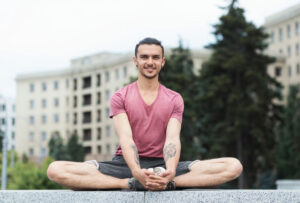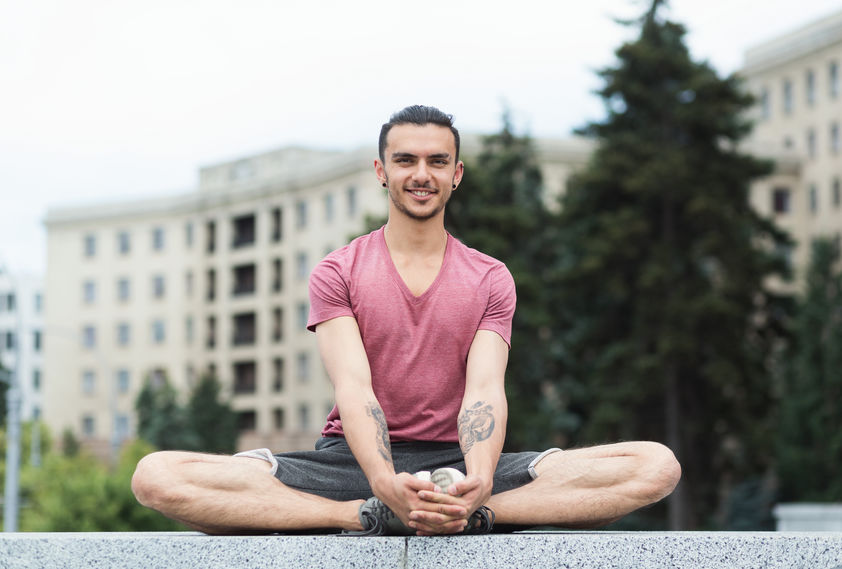After following him for a year and watching his training methods and philosophy unfold through his posts, I jumped at the opportunity to be his student when he created an online training option. It is still an emerging training method, so finding an instructor in your area may be challenging.

What is Kinstretch?
Although the word “stretch” is in the name, don’t be fooled. Most of the class is spent creating tension, fighting for every last millimeter of movement. Kinstretch is best classified as highly-specialized strength training; you’re trying to gain control over your body at the limits of its ROM.
The first Kinstretch instructor certification took place in Oregon in 2016. These instructor certification seminars have expanded across the US and worldwide. To ensure that they have a foundation of principles of human movement, all Kinstretch instructors must first complete the Functional Range Conditioning certification seminar (16 hours) before completing the Kinstretch certification seminar (16 additional hours).
My First Class
To physically prepare for your first Kinstretch experience, the most you will need is two yoga blocks, two tennis balls, two dowels, and a mat. As I pressed play on my first online class, I began a process for which I had not mentally prepared myself.
The class began with CARs (Controlled Articular Rotations). Using muscular irradiation (contracting surrounding muscle groups to increase muscle activation) to maintain isometric tension throughout the rest of the body, each joint is moved through its full range of motion for several reps, beginning with the cervical spine and working all the way down to the toes.
This first class focused mainly on adductors, abductors, hip flexors, and quadriceps. In all Kinstretch classes, you are working at the ends of your ROM, both stretched and contracted. I was quickly introduced to the concept of PAILs and RAILs (Progressive Angular Isometric Loading and Regressive Angular Isometric Loading).
PAILs and RAILs are isometric contractions of stretched muscle tissue to help the body gain control over its newly found passive ROM. In this case, I sat in the butterfly stretch for 2-3 minutes. As the muscle tissue of my adductors relaxed into the stretch, I leaned forward to grab my ankles and placed my elbows on the inside of my knee to create a block for the coming contraction.
For 20-30 seconds I ramped up my isometric contraction to my greatest effort, resisting movement by pressing my arms against the attempted hip adduction (PAILs contraction). I then shifted immediately into engaging my hip abductors to draw my knees further away from my arms and as close to the ground as possible (RAILs contraction).
After several rounds of these contractions, my knees went from six inches off the ground to nearly flat on the ground in their relaxed state.
The work that followed cramped both my abdominals and quadriceps. Cramping is not unexpected when doing this type of training. Now my body was unfamiliar with the process, so pushing through the cramping allowed me to have better neuromuscular control through my newfound ROM.
Results
At the end of this first session, which lasted a little over an hour, I was exhausted and sweating. Because I was working at the ends of my ROM, I never worked so hard to move so little.
I felt like my hips were able to move more freely, though I didn’t have the energy to test it out. I woke up the next morning with that same feeling of freedom in my lower body that I had immediately following the end of my first class.
That evening I went to play my usual soccer game, and I felt like I was gliding on air. The amount of effort I had to put forth to sprint was drastically reduced, and I was covering more ground than I normally do. These immediate results left me stunned and wanting to see where dedicating time to my mobility could take me.
As I’ve gained more experience in this training modality, I have noticed additional benefits in the gym and in my everyday life. In the gym, I’m better able to create global tension during my main barbell exercises, have developed a better mind-muscle connection and improved my technique.
In my everyday life I’m feeling less restricted, less achy, and better able to recover from workouts and soccer games.
Beyond improved performance is injury prevention. The larger ROM over which someone has control, the less likely they are to get injured. It’s important to include specific mobility work in both our clients’ programs and our own routines to help prepare our bodies for the unexpected.
Who Can Benefit?
Anyone who can move can benefit from Kinstretch. It is used by professional sports teams in the NFL, MLB, NBA, and NHL as well as individual athletes in the UFC to maximize performance. It is also used in the physical therapy setting as a way for patients to regain and improve motor control, body awareness, joint health, and intrinsic strength.
Each individual is responsible for monitoring his or her own level of effort when employed Kinstretch techniques, so an appropriate stimulus can be identified by each participant regardless of their current level of fitness.
How Does it Fit with the Rest of My Training?
Its instructors will tell you that it does not take the place of other training modalities, but rather prepares you for participating in those other methods. Used as a supplement to your preferred activity, Kinstretch promises to enhance your active ROM, preparing your body for the rigors of sport, training, or everyday life.
Try Something Different
As fitness professionals, sometimes it can feel like we should be able to rely on our own skillset to master our own movement. However, this hubris may be a hindrance, justifying avoidance of learning new methods that can help both you and your clients.
While we encourage our clients to try new ways of moving their bodies, we should lead by example and also step out of our comfort zone, too. Having done this myself with Kinstretch, I can say with confidence that my body and my daily life have reaped the benefits.



